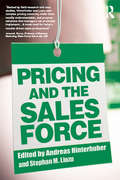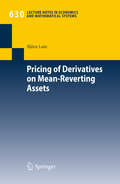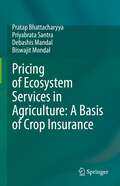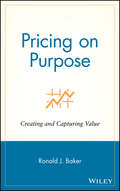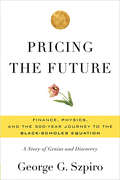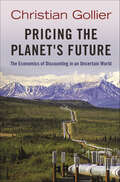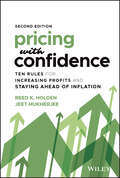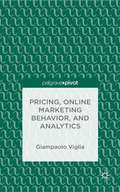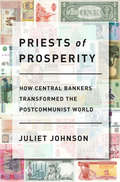- Table View
- List View
Pricing and the Sales Force
by Andreas Hinterhuber Stephan M LiozuPricing and the Sales Force is the first book to link pricing strategy and the sales force together. Pricing strategy is now well established as an important means of driving profits for many organizations. Countless companies are now mastering price-setting. But what about "price-getting" – converting those list prices into the realized sales, and as a result, greater profitability? This is the domain of the sales force. A selection of the world’s leading specialists explore different aspects of sales force and pricing strategy integration: introduction: overview on the state of the art; building key capabilities: best practices for building sales force capabilities in pricing and value quantification; engaging the sales force: driving organizational change processes with the sales force; designing effective selling processes: designing and implementing processes that enable superior performance, and; aligning sales force incentives and building the infrastructure: insights into how to align sales force incentive schemes; tools and instruments to enable the sales force to perform. The third in Hinterhuber and Liozu’s successful pricing series, this book is essential reading for pricing strategy and sales scholars and practitioners.
Pricing at Netflix
by Elie Ofek Marco Bertini Amy Klopfenstein Oded KoenigsbergSince its launch in 1998 as "the Amazon.com of DVDs," Netflix had evolved from a DVD rental company to a video streaming platform and producer of original films and television shows. As the company matured, it regularly increased prices and adjusted its product offerings while continuing to add new subscribers. However, between late 2019 and mid-2020, competition within the streaming industry intensified with the launch of new entrants such as Disney+, Apple TV+, and HBO Max, jeopardizing Netflix's position as the industry leader. In spite of the heightened competition in the streaming industry, some analysts and customer willingness-to-pay surveys suggested that Netflix had the opportunity to implement another rate hike in the near future. By May 2020, Netflix must decide whether to increase prices again, or whether it should consider a different pricing model altogether.
Pricing for Profit
by Peter HillPrice is the most significant factor affecting the profitability of every business, profit centre or department. When the pressure is on to perform or grow, your instinct may be to discount, undercut your competitors, cut costs and promote through price. Yet these are often the last things you should do. Pricing for Profit is the most practical guide on pricing available. Using a firm, profit-focused framework developed running real projects for real businesses, this book shows you how by getting your pricing structures right you can make a huge difference to your bottom line. It gives business owners, managers and leaders simple, achievable pricing strategies that will deliver sustainable business growth. Can you afford to leave money on the table? If not, Pricing for Profit is the guide for you.
Pricing for Profit: Multi-Part Pricing in the U.K. Credit Card Industry
by Peter J. CoughlanExamines the optimal pricing mechanism for credit cards.
Pricing for Profit: The UK Credit Card Industry in the Late 1980s (A)
by Harborne W. Stuart Jr.Describes the United Kingdom credit card industry in the late 1980s, which was really three businesses: a cashless transaction business for merchants, a cashless transaction business for card holders, and a credit business for card holders. At the time of the case, overall profitability has dropped significantly. Added value analysis is used to identify that one of the three businesses is unlikely to remain profitable (cashless transactions for merchants). With this loss of profitability, the case then considers how to limit the losses in the one business that had already been unprofitable (cashless transactions for card holders). This latter step is a problem in interactive decision theory in which players have different perceptions about the game, and these perceptions, in turn, may be influenced by each other.
Pricing for Profit: The UK Credit Card Industry in the Late 1980s (B)
by Harborne W. Stuart Jr.Supplements the (A) case.
Pricing for Profit: The UK Credit Card Industry in the Late 1980s (C)
by Harborne W. Stuart Jr.Supplements the (A) case.
Pricing for Profit: The UK Credit Card Industry in the Late 1980s (D)
by Harborne W. Stuart Jr.Supplements the (A) case.
Pricing in Business (Routledge Library Editions: Industrial Economics #23)
by Douglas HagueThis book, first published in 1971, reports on the first detailed study of pricing decisions ever made in the UK. Based on case studies, it shows precisely how thirteen pricing decisions were taken. In doing so, it reveals the objectives pursued by these firms and how conflicts between these objectives were resolved. The assessments of the pricing decisions show the strengths and weaknesses of the procedures used by the firms, and the relative importance of economic and organizational elements in such decisions.
Pricing in General Insurance
by Pietro ParodiBased on the syllabus of the actuarial profession courses on general insurance pricing – with additional material inspired by the author’s own experience as a practitioner and lecturer – Pricing in General Insurance, Second Edition presents pricing as a formalised process that starts with collecting information about a particular policyholder or risk and ends with a commercially informed rate. The first edition of the book proved very popular among students and practitioners with its pragmatic approach, informal style, and wide-ranging selection of topics, including: Background and context for pricing Process of experience rating, ranging from traditional approaches (burning cost analysis) to more modern approaches (stochastic modelling) Exposure rating for both property and casualty products Specialised techniques for personal lines (e.g., GLMs), reinsurance, and specific products such as credit risk and weather derivatives General-purpose techniques such as credibility, multi-line pricing, and insurance optimisation The second edition is a substantial update on the first edition, including: New chapter on pricing models: their structure, development, calibration, and maintenance New chapter on rate change calculations and the pricing cycle Substantially enhanced treatment of exposure rating, increased limit factors, burning cost analysis Expanded treatment of triangle-free techniques for claim count development Improved treatment of premium building and capital allocation Expanded treatment of machine learning Enriched treatment of rating factor selection, and the inclusion of generalised additive models The book delivers a practical introduction to all aspects of general insurance pricing and is aimed at students of general insurance and actuarial science as well as practitioners in the field. It is complemented by online material, such as spreadsheets which implement the techniques described in the book, solutions to problems, a glossary, and other appendices – increasing the practical value of the book.
Pricing of Derivatives on Mean-Reverting Assets
by Björn LutzThe topic of this book is the development of pricing formulae for European style derivatives on assets with mean-reverting behavior, especially commodity derivatives. For this class of assets, convenience yield effects lead to mean-reversion under the risk-neutral measure. Mean-reversion in the log-price process is combined with other stochastic factors such as stochastic volatility, jumps in the underlying and the price process and a stochastic target level as well as with deterministic seasonality effects. Another focus is on numerical algorithms to calculate the Fourier integral as well as to integrate systems of ordinary differential equations.
Pricing of Ecosystem Services in Agriculture: A Basis of Crop Insurance
by Debashis Mandal Pratap Bhattacharyya Priyabrata Santra Biswajit MondalThe book deals with the pricing of ecosystem services provided by agriculture. All provisioning, regulating, supporting and cultural services are being covered in this title. Chapters in this contributed volume cover topics such as pricing of services from the soil, water, and nutrient management. Quantified monetary values of carbon sequestration and renewable energy applications in agriculture are covered with clear-cut methodologies. This book also links ecosystem service-based pricing with crop insurance. Improving the farmers’ livelihood is the central goal of the agricultural production system throughout the world. Under the climate change context, farms’ produce is now climate-vulnerable and heavily dependent on weather conditions. Moreover, we often neglect the contribution of several positive impacts of agricultural practices on ecosystems and natural resources. Therefore, there is a need to quantify and value these ecosystem services in agriculture. However, valuation and pricing the services in agriculture both tangible and intangible is a challenge. It is necessary to have clear-cut methodologies for pricing ecosystem services of agriculture in terms of net monetary benefits. The ecosystem service-based pricing could be a solid basis for calculating the insurance to farmers in case of occurrence of natural hazard and associated crop damage. This book is of interest to scholars, teachers, researchers, environmental scientists, watershed managers, capacity builders, and policymakers. The book also serves as effective reading material for undergraduate and graduate students of agriculture economics, ecology, agronomy, and environmental sciences. National and international agricultural scientists, policymakers will also find this to be useful.
Pricing on Purpose
by Ronald J. BakerPricing on Purpose explores the importance of pricing, one of the four Ps (product, promotion, place, and price) of marketing, that is largely ignored in business literature. Pricing is the opportunity for a business to capture the value of what it provides to the customer, and deserves as much attention as promotion, product and place in the marketing strategy of any business. This book calls attention to the market share fallacy, explains the difference between cost-plus pricing and value pricing, and provides best-practice pricing examples. It presents the theory of value--long established in the economics profession--and how any business can use various pricing strategies to communicate and capture the value of their products and services.
Pricing the Future: Finance, Physics, and the 300-year Journey to the Black-Scholes Equation
by George G. SzpiroOptions have been traded for hundreds of years, but investment decisions were based on gut feelings until the Nobel Prize-winning discovery of the Black-Scholes options pricing model in 1973 ushered in the era of the "quants." Wall Street would never be the same. In Pricing the Future, financial economist George G. Szpiro tells the fascinating stories of the pioneers of mathematical finance who conducted the search for the elusive options pricing formula. From the broker's assistant who published the first mathematical explanation of financial markets to Albert Einstein and other scientists who looked for a way to explain the movement of atoms and molecules, Pricing the Future retraces the historical and intellectual developments that ultimately led to the widespread use of mathematical models to drive investment strategies on Wall Street.
Pricing the Planet's Future: The Economics of Discounting in an Uncertain World
by Christian GollierOur path of economic development has generated a growing list of environmental problems including the disposal of nuclear waste, exhaustion of natural resources, loss of biodiversity, climate change, and polluted land, air, and water. All these environmental problems raise the crucial challenge of determining what we should and should not do for future generations. It is also central to other policy debates, including, for example, the appropriate level of public debt, investment in public infrastructure, investment in education, and the level of funding for pension benefits and for research and development. Today, the judge, the citizen, the politician, and the entrepreneur are concerned with the sustainability of our development. The objective of Pricing the Planet's Future is to provide a simple framework to organize the debate on what we should do for the future. A key element of analysis by economists is the discount rate--the minimum rate of return required from an investment project to make it desirable to implement. Christian Gollier outlines the basic theory of the discount rate and the various arguments that favor using a smaller discount rate for more distant cash flows. With principles that can be applied to many policy areas, Pricing the Planet's Future offers an ideal framework for dynamic problems and decision making.
Pricing the Priceless: Covering Transformational Medicines at Harvard Pilgrim Health Plan
by Amitabh Chandra Sofia GuerraCase
Pricing the Priceless: The Financial Transformation to Value the Planet, Solve the Climate Crisis, and Protect Our Most Precious Assets
by Paula DiPernaAn exciting exploration of the new frontier of finance, to value the planet and protect what has too long been treated as free and taken for granted--the natural assets we need and love most In Pricing the Priceless: The Financial Transformation to Value the Planet, Solve the Climate Crisis, and Protect Our Most Precious Assets, renowned environmental strategist, speaker, world traveler and author Paula DiPerna brings a unique voice and optic to de-mystify and unveil today’s most fascinating financial disruption—pricing the priceless to flip conventional ideas of how we value natural assets and why. She asks the provocative question long ignored: Why do we value the indispensable atmosphere at zero, but dispensable production in the trillions? She digs into alternatives, with real-life examples from around the globe of fascinating and pioneering financial innovations—controversial and paradoxical, but essential. In the book, you’ll travel from rainforests to Wall Street, Board Rooms to the Vatican, coral reefs to mangroves to China’s carbon markets. Timely, adventurous, eclectic, and accessible, Pricing the Priceless brings alive the critical financial transformation that will determine future planetary health and social stability. With power, clarity and real-world experience, the author also examines: Fascinating new financial inventions and experiments—insurance, bonds, markets, investment funds—all aimed at pricing what is precious and vital to human well-being How the great current intergenerational shift in wealth and attitudes is redefining investment trends and the idea of what constitutes wealth and return How climate change and other urgent environmental problems now require entirely new financial thinking to trigger solutions How once-radical ideas about measuring economic progress are now re-imagining the very purpose of capitalism Why finance needs critical re-invention to remain credible in the face of increasing public skepticism of business-as-usual economic practice A can’t-miss read for thought leaders, business executives, investors, activists, and entrepreneurs, Pricing the Priceless is a landmark that will shape the world and future, bridging the tangible and intangible to answer a critical question of rising economic and social inspiration: What is money for?
Pricing with Confidence
by Mark Burton Reed HoldenBad pricing is a great way to destroy your company's value, revenue, and profits. With ten simple rules, this book shows you how to deliver both healthy profit margins and robust revenue growth while kicking the dreaded discounting habit. The authors destroy the conventional wisdom that you have to trade margins for revenues and show you how to fully exploit the value your company offers customers. This is a proven plan for increasing sales without sacrificing profits.
Pricing with Confidence: Ten Rules for Increasing Profits and Staying Ahead of Inflation
by Reed K. Holden Jeet MukherjeeNavigate Inflation, Keep Valuable Customers, Increase Profits As you read this, inflation is steadily and (not so) slowly eating into your profit margins. Simultaneously, your sales teams are using discounts and rebates as crutches to help them close sales, even as this habit threatens the profitability of your business. In the newly revised second edition of Pricing with Confidence: Ten Rules for Increasing Profits and Staying Ahead of Inflation, world-renowned pricing consultants and thought leaders Reed K. Holden and Jeet Mukherjee deliver a compelling argument against the conventional view that there is a tension between revenue growth and profit growth. In the book, you&’ll learn how your firm can enjoy both even as it stays ahead of inflation. The authors also explore: The importance of a sound pricing strategy to protect profits How stellar analytics and quality metrics can help you set the perfect price Innovation as the life blood of organizational growth How to set sales team and customer expectations, keep valuable customers, and achieve value from technology Building your &“selling backbone&” to prepare for tough negotiations and draft profitable RFPsA can&’t-miss update to one of the most valuable pricing resources on the market today, Pricing with Confidence belongs in the libraries of pricing managers, executives, founders, entrepreneurs, independent professionals, and anyone else expected to help their organization grow revenues while simultaneously improving margins.
Pricing, Online Marketing Behavior, and Analytics
by Giampaolo VigliaBehavioral Pricing, Online Marketing Behavior, and Analytics covers many different aspects of how online marketing works and its continuous evolution.
Pricing, Profits and Customer Value
by Frank V. Cespedes Benson P. Shapiro Elliot B. RossThis note discusses how some firms (start-ups and established companies) maximize customer value and profits via their pricing processes. It is aimed at companies that compete on the basis of performance initiatives rather than absolute cost advantages and low price. It is suitable for use in courses or modules in Pricing, Entrepreneurial Management, Strategy, or Marketing.
Pricing: A Value-Based Approach
by Robert J. DolanPresents a framework for determining prices for products and services in concert with the value provided to customers. Discusses methodologies for estimating customer value.
Pricing: Design and Implementation
by Samuel ChunProvides general managers with a framework with which they can structure and understand pricing decisions. Draws examples from existing HBS case materials.
Pride Before the Fall: The Trials of Bill Gates and the End of the Microsoft Era
by John HeilemannPride Before the Fall is the definitive account of the trial that shook an economy: United States v. Microsoft. Award-winning journalist John Heilemann uncovers the explosive truth behind the headlines: how the high-tech kingpins Bill Gates had tried to destroy, together with a motley crew of anonymous crusaders, worked in secret to help the government take down the most powerful empire of the information age. As colorful and riveting as a detective novel, Pride Before the Fall is an unforgettable tale of human ambition and human frailty - a timely saga of arrogance, hubris, ruthlessness, and revenge.e
Priests of Prosperity: How Central Bankers Transformed the Postcommunist World
by Juliet JohnsonPriests of Prosperity explores the unsung revolutionary campaign to transform postcommunist central banks from command-economy cash cows into Western-style monetary guardians. Juliet Johnson conducted more than 160 interviews in seventeen countries with central bankers, international assistance providers, policymakers, and private-sector finance professionals over the course of fifteen years. She argues that a powerful transnational central banking community concentrated in Western Europe and North America integrated postcommunist central bankers into its network, shaped their ideas about the role of central banks, and helped them develop modern tools of central banking. Johnson's detailed comparative studies of central bank development in Hungary, the Czech Republic, Slovakia, Russia, and Kyrgyzstan take readers from the birth of the campaign in the late 1980s to the challenges faced by central bankers after the global financial crisis. As the comfortable certainties of the past collapse around them, today’s central bankers in the postcommunist world and beyond find themselves torn between allegiance to their transnational community and its principles on the one hand and their increasingly complex and politicized national roles on the other. Priests of Prosperity will appeal to a diverse audience of scholars in political science, finance, economics, geography, and sociology as well as to central bankers and other policymakers interested in the future of international finance, global governance, and economic development.
